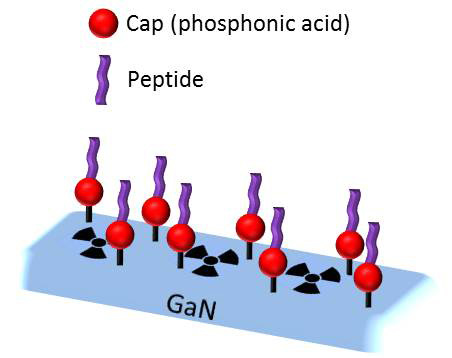New Technique Moves Researchers Closer to New Range of GaN Biosensors
For Immediate Release
Researchers from North Carolina State University have found a way of binding peptides to the surface of gallium nitride (GaN) in a way that keeps the peptides stable even when exposed to water and radiation. The discovery moves researchers one step closer to developing a new range of biosensors for use in medical and biological research applications.

GaN is a biocompatible material that fluoresces, or lights up, when exposed to radiation. Researchers are interested in taking advantage of this characteristic to make biosensors that can sense specific molecules, or “analytes,” in a biological environment.
To make a GaN biosensor, the GaN is coated with peptides – chains of amino acids that are chemically bound to the surface of the material. These peptides would respond to the presence of specific analytes by binding with the molecules.
The idea is that, when exposed to radiation, the intensity of the light emitted by the GaN would change, depending on the number of analytes bound to the peptides on the surface. This would allow researchers and clinicians to monitor the presence of different molecules in a biological system. But it’s not quite that simple.
“A key challenge in developing GaN biosensors has been finding a technique to bind the peptides to the GaN surface in a way that keeps the peptides stable when exposed to aqueous environments – like a cell – and to radiation,” says Dr. Albena Ivanisevic, senior author of a paper on the work and an associate professor of materials science and engineering at NC State. “Now we have done that.”
“We used a two-step process to bind the peptides,” explains Nora Berg, a Ph.D. student at NC State and lead author of the paper. “First we used a combination of phosphoric and phosphonic acids to etch the GaN and create a stable ‘cap’ on the surface. We were then able to attach the relevant peptides to the phosphonic acids in the cap.”
To determine the stability of the peptides, the researchers placed the coated GaN in an aqueous solution and then placed the solution in a “phantom material” that mimics animal tissue. The GaN, solution and phantom material were then exposed to high levels of radiation, beyond what would be expected in a clinical setting. The material was then evaluated to see if there was any degradation of the peptides or of the GaN itself.
“The peptides remained on the surface,” Berg says. “The aqueous solution caused an oxide layer to form on the surface but there is no indication that this would affect the functionality of the peptides.”
“Now that we’ve shown that this approach allows us to create functional, stable peptide coatings on this material, we’re moving forward to develop a particle configuration – which would be injectable,” Ivanisevic says. “This will open the door to in vitro testing of the material’s sensing capabilities.”
The paper, “Surface Characterization of Gallium Nitride Modified with Peptides Before and After Exposure to Ionizing Radiation in Solution,” was published online Dec. 5 in the journal Langmuir. The paper was co-authored by Dr. Michael Nolan, an assistant professor of radiation biology and oncology at NC State, and Dr. Tania Paskova, a research professor of electrical engineering at NC State.
-shipman-
Note to Editors: The study abstract follows.
“Surface Characterization of Gallium Nitride Modified with Peptides Before and After Exposure to Ionizing Radiation in Solution”
Authors: Nora G. Berg, Michael W. Nolan, Tania Paskova, and Albena Ivanisevic, North Carolina State University
Published: Online Dec. 5, 2014, Langmuir
DOI: 10.1021/la5040245
Abstract: An aqueous surface modification of gallium nitride was employed to attach biomolecules to the surface. The modification was a simple two-step process using a single linker molecules and mild temperatures. The presence of the peptide on the surface was confirmed with X-ray Photoelectron Spectroscopy. Subsequently, the samples were placed in water baths and exposed to ionizing radiation to examine the effects of the radiation on the material in an environment similar to the body. Surface analysis confirmed degradation of the surface of GaN after radiation exposure in water; however, the peptide molecules successfully remained on the surface following exposure to ionizing radiation. We hypothesize that during radiation exposure of the samples, the radiolysis of water produces peroxide and other reactive species on the sample surface. Peroxide exposure promotes the formation of a more stable layer of gallium oxyhydroxide which passivates the surface better than other oxide species.
- Categories:


